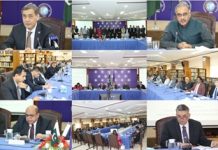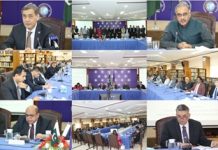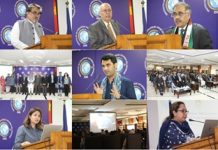Afghanistan has also become divided along ethnic lines, and may face the same fate as Iraq if the US and NATO forces fail in their avowed mission of nation and state building
The year 2006 has not been good for Afghanistan, its people or the coalition states fighting a counterinsurgency war against the Taliban. By all accounts, the year witnessed a remarkable come back by the Taliban, or whatever appellation one might want to give the insurgents currently operating in southern and eastern Afghanistan.
Two emerging trends in the Afghan war are noteworthy: First is the coming on the scene of the suicide-bomber, blowing himself up in crowed places or very close to the Afghan and NATO forces in the region. Hitherto, it was thought that suicide bombing was a problem unique to the Middle East. That is no longer the case. The suicide-bomber has become the most dangerous weapon of our time, and he is now present in Afghanistan as well.
The second important development is increasing conventional attacks by the Taliban forces despite sizeable losses to themselves. This shows that the Taliban have a big presence and are better armed and organised than in any previous year. Obviously, the International Security Assistance Force, and now NATO having taken control of command and operations, has failed to achieve its objectives of stabilising, securing and reconstructing the war-torn Afghanistan. There is no, and cannot be any better evidence of their failure in Afghanistan than the rise of the Taliban forces, emergence of Afghanistan as a narcotics state, and the persistence of the warlord phenomenon.
Let us consider why NATO is failing and the Taliban consequently appear to be succeeding in at least mounting regular and increasingly lethal attacks. The first problem of the US that is leading the war in Afghanistan, and that of NATO is that they do not seem to be recognising or openly admitting the identity of the insurgents in Afghanistan, continuing to brand them as Taliban. This label and the images associated with it invoke international sympathy for the US and NATO forces in their respective countries because of the popular perceptions of the Taliban as ‘Islamic’ militants, medieval in thinking and hostile to the West and modernity. The Taliban are very important, perhaps even a critical element in the insurgency, but it is neither exclusively Taliban in character nor entirely motivated by religious factors.
Behind the Taliban façade is the Pashtun ethnicity. Afghanistan’s three wars against two great powers, Britain and the former Soviet Union, revolved around the expression of Afghan nationalism and its conventional resistance to the presence of foreign forces. In these wars, the Pashtun raised the flag of Afghan nationalism, mobilised resistance and paid the heaviest price in human and material terms. One may argue that there are also Pashtun and other ethnic Afghans on the side of the international forces. But there were also Afghans with the former Soviet Union, and quite a few with Britain as well.
This is in fact a dangerous symptom of political polarisation in the country. The leaders of the northern ethnic minorities, President Hamid Karzai and his allies are very keen to have the NATO-ISAF forces finish the tough job of securing, reconstructing and stabilising Afghanistan before leaving. Thus their primary political interest is to defeat the insurgency raging in the Pashtun regions. But this is not happening, and may not happen until the US and NATO forces do a serious review of the policies and effect a big course correction.
In the recent annual NATO summit meeting in Riga, Latvia, and before it, in many of the statements of commanders dealing with Afghanistan, three dominant themes have informed their deliberations: first, Afghanistan is a very important country and the security of the world and surrounding regions in the new century would depend on how it is rebuilt, made secure and stabilised. One cannot disagree with this prognosis and the likely implications of the failure of the international coalition in Afghanistan.
The second important subject of discussion is that NATO needs more forces on the ground to combat the surging tide of the Taliban. There are already 32,000 NATO troops in Afghanistan. In addition, the United States operates 11,000 troops outside the NATO command for logistics and anti-terrorism purposes. It seems, for good reasons, that some of the NATO member-states are not willing to send more troops to Afghanistan because it is a high-risk combat theatre and so far the results of military operations there have not been too positive or visible.
Facing reluctance on the part of NATO countries to the idea of more troops, the alliance commanders have sought the dropping off of restrictions on the deployment of troops to combat zones in the south and east of the country. They have secured an agreement in the Riga meeting on calling troops from other countries present in Afghanistan into combat zones from the areas of their regular deployment. In emergencies and in volatile areas, the US, British and the Netherlands forces have done most of the fighting. While this policy may give the commanders some flexibility and increase their troop strength to an optimal level, it hardly presents a long-term or realistic solution to the growing insurgency.
NATO needs to focus on a three-pronged strategy to stabilise Afghanistan. First and foremost it needs to address the issue of Pashtun alienation. There has been good progress on the Pashtun representation in the power structure since the parliamentary elections, but more needs to be done. The perception among the Pashtun about the power-shift in favour of Tajiks and other groups persists and that is not a good political sign. Secondly, NATO must focus with greater commitment on the reconstruction programmes and the revival of legal economy. Unfortunately, drug production and trafficking have increased at alarming rates, providing the insurgents with resources and local support for the protection they provide to the poppy cultivators. This also demonstrates the failure of the international agencies in providing alternative sources of livelihood to the people who seem to have fallen back on the old practice of drug production.
Third, and in my view the most important and effective way of stabilising Afghanistan, would be peace talks and agreements with the Pashtun tribal leaders and those Taliban who are willing to come to the negotiating table.
The American-led war in Iraq has had demonstrable political and psychological effects on the situation in Afghanistan. As the US approaches the endgame in Iraq, it must focus on Afghanistan, wiser with the lessons learnt in the course of the Iraq tragedy. One of the lessons that one can learn from Iraq, which now teeters on the brink of disintegration, is that different social groups locked in a power struggle need outside help to evolve institutions and political consensus to live in harmony.
Afghanistan has also become divided along ethnic lines, and may face the same fate if the US and NATO forces fail in their avowed mission of nation and state building.
The author is a professor of Political Science at the Lahore University of Management Sciences.













